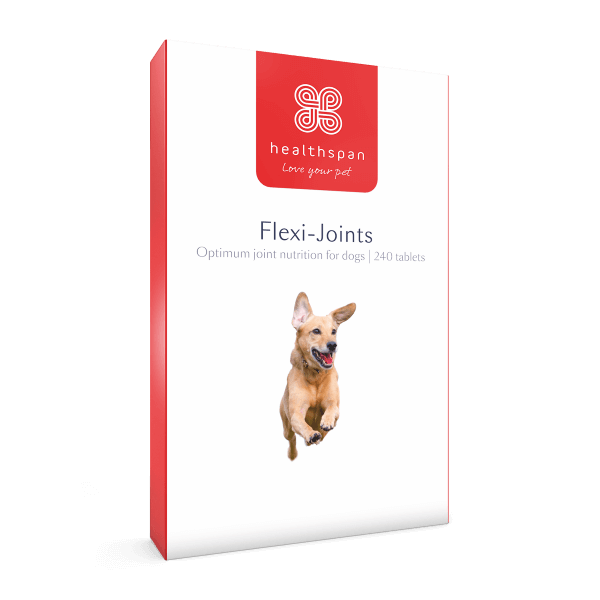Arthritis can be a debilitating condition in any pet, but when arthritis is diagnosed in young dogs it is particularly saddening. We've put together some information to help you care for your young dog.
Understanding canine arthritis
Joint pain secondary to arthritis in dogs is highly variable. A dog may have 'terrible hips' as seen on an x-ray, but not show any signs, while another dog may have one tiny bone chip in his elbow and refuse to use his leg. Arthritis is generally seen to be a greater problem in big dogs, but small dogs can develop chronic pain with arthritis as well.1
Luxating patellas (slipping knee caps) is a common condition in toy breeds and can cause limping, bunny-hopping and pain in the hind limbs. For all dogs, arthritis can lead to obesity and obesity-related health problems because of an unwillingness to exercise, and if a dog's joints are particularly painful, you might see changes in behaviour or signs of aggression develop.
What can cause arthritis in young dogs?
A common cause of arthritis in young dogs is joint dysplasia. Dysplasia means 'abnormal growth' - dysplastic joints grow abnormally and predispose dogs to developing arthritis at a young age. Hip and elbow dysplasia are commonly seen in large breed puppies and can cause the early onset of arthritis and pain if not treated.2 Hip and elbow dysplasia are an especially common problem in large dogs, so watch out if your young pup is due to develop into a larger dog.
Hip and elbow dysplasia are thought to be a genetic disease that is exacerbated by environmental conditions, such as improper nutrition or exercise in large breed puppies. Hip dysplasia is more common than elbow dysplasia and affects one or both hind limbs.
Elbow dysplasia is a combination of four elbow defects that may affect one or both front legs. Despite these both being painful conditions for your dog, hip and elbow dysplasia can be rectified to an extent with surgical therapy, but can also be managed non-surgically.
In young dogs, arthritis is most commonly caused by trauma to a joint, or a developmental abnormality. Arthritis can also develop secondary to an infection, such as Lyme disease or other tick-borne diseases, but this is less common than trauma or developmental diseases.

Flexi Joints for Dogs
An advanced supplement containing glucosamine and chondroitin to help support your dog's joint health
- Provides essential building blocks to help your dog maintain healthy working joints and stay active
- Glucosamine HCl and Chondroitin, vitamins C and E
- Tasty beef-flavoured tablets
Symptoms to look out for
Symptoms of arthritis in young dogs include limping, holding one or more legs up, a stiff, stilted gait, reluctance to exercise, decreased interest in games, excessive licking, yelping, increased sleeping, paradoxical muscle gain in unaffected limbs, bunny-hopping, muscle loss over hind limbs, and increased aggression. So look out for any changes in their behaviour or everyday routines: are they doing anything differently, has their movement been affected at all, or do they not seem as affectionate as usual?
My young dog has arthritis. What next?
For dogs that are symptomatic, early intervention is the best way to maintain good quality of life, and this usually requires some form of surgical procedure. If the condition goes untreated, this can cause progression of the arthritis, lifelong pain and difficulty walking or running.
Manage their weight
The most important way to take care of any young dog diagnosed with arthritis is to manage their weight. Dogs that are too heavy have greater stress and strain on their joints, will be less inclined to exercise and may be in chronic pain. A dog is at an ideal body condition (weight) when you can feel their ribs but not see them.
An easy way to determine this is to use the 'hand test'. Have your dog stand up and feel their ribs with your hands. If the ribs feel like the back of your hand, your dog is at a healthy weight. If the ribs feel like your palm, your dog is too heavy, or if their sides feel like your knuckles, they may be underweight.
Choose the right bed
Dogs with painful, swollen joints also benefit from a supportive sleeping surface. When choosing a bed for your young dog, stay away from beds cushioned with box springs or polyfill and choose thick memory foam instead. There are specialised dog bed manufacturers dedicated to making beds just for large dogs or to provide additional support for fragile joints.
Maintain muscle mass
It is important for young dogs with arthritis to try to maintain healthy muscle mass in their legs. Muscle helps support joints, but running and other high-impact activities may be difficult for young dogs with arthritis. Swimming is a wonderful exercise for dogs with arthritis: it works their cardiovascular system, boosts metabolism and helps maintain healthy muscles and joints. Regular exercise also helps the joints stay mobile by increasing the production of joint fluid.






